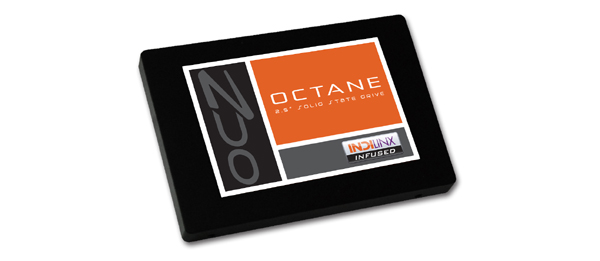Hard choices: SSDs
Solid as a moderate-to-expensively priced rock
With my last instalment deftly punting the dreary but essential matter of motherboards into touch, it's time to get back to something sexy. That's right, RPSers, solid state storage gives me trouser tentage. I love SSDs, and I'm here to tell you which three drives are the ones you should be pointing your wallet at.
The reason I love SSDs so hard is because nothing does more to pep up the subjective feel of your PC than the switch from silly spinning platters to solid slivers of silicon. It's true that, for many games, once you've loaded a level storage performance isn't hugely critical. But even there, snappy loading times make the whole experience more pleasant. If nothing else, sitting and waiting while your hard disk apparently chews a brick can really spoil that suspension-of-disbelief spell.
More importantly, quite a few modern games are frequently caching game data on the fly. With a hard disk, that can manifest itself in those irritating little stalls and stutters. And if I may breach my RPS contract momentarily and mention non-games PC usage, once you've gone solid state for general application and multi-tasking work, you won't want to go back. While CPUs stagnate, solid state storage is where all the exciting progress is happening.

Magnetic platters: not the best way to serve up decent storage performance
If that makes now a good time to go solid, another recent development is the arrival of SSDs that deliver half-decent value for money. £150 or less is where I like to see a component class settle in terms of bang for buck. For CPUs that means a Core i5 quad-core chip, for instance. And now SSDs have achieved critical mass with high performance models slipping under the £150 barrier, and by some margin.
The major proviso here, of course, is capacity. We're talking drives in the 100GB to 128GB range. Personally, I think that's enough. You put your OS and critical applications – most importantly that Steam installation – on the SSD, the rest you chuck on a traditional disk.
That sounds straight forward. The problem is that, as a broad technology, SSDs are a complete pain in the arse. I've been testing the twangers off the things since they went mainstream about four years ago and the goal posts just keep on changing. A whistle stop tour of the new foibles, metrics, specs and issues that have popped up includes drive stuttering, Trim support, channel width, MLC vs SLC NAND, IOPS vs sequential throughput, data compression, write amplification, synchronous and asynchronous memory, toggle NAND and, well, a helluva a lot more.
Bottom line is that SSDs aren't like CPUs and GPUs. Testing them is tricky enough when they're new. And weird things can happen when you use them long term. Anyway, trawling through all the issues in detail would be positively encyclopaedic. And ultimately pretty futile. So, here's what you actually need to know.

The new 520 Series SSD ain't exactly 'Intel Inside'
Controller chipsets are key. They're really hard to get right. Even Intel has given up trying to make fast controllers and has started buying them in. So not many companies make them and a lot of drives that are branded differently have the same chipset. However firmwares do differ, which we'll come to in a moment.
Right now, the best chipsets come from SandForce, Samsung, Marvell and OCZ (the latter in the form of recently acquired Indilinx). To employ some sweeping generalisations, SandForce is quick outright thanks to data compression, but not so great with incompressible data (think music, images and video) and real-world performance also falls off with smaller capacity drives.
Samsung has a good reputation for stability and reliability and strong all round performance even with smaller capacities but doesn't quite reach the dizzy peaks of the best SandForce drives. As for Marvell and OCZ, the former is similar in stature to Samsung and the latter is the newbie currently proving itself.

It's still early doors for OCZ's new Indilinx Everest controller chipset
Next up, MLC vs SLC memory is easy. Almost everything in the consumer space is MLC. It stands for Multi-Level Cell and that means higher data density for less money. SLC is faster but just too pricey. As for synchronous and asynchronous, you want synchronous. It's more expensive, but only slightly, and faster, so it's worth the small premium. For the record, toggle NAND is similar to synchronous NAND, so that's OK, too.
On a more general note, do not be seduced by peak sequential read and write performance. Random access that relies on IOPS performance (or Input-Output Operations Per Second) is just as important. That said, you'll want to make sure any drive you buy supports 6Gbps SATA rather than 3Gbps to make the most of the peak performance on offer (though motherboards older than a year or two maybe not support the 6Gbps interface in any case).
Finally, TRIM support, which ensures data is fully deleted rather than merely marked for deletion and therefore clogs up the drive, is essential but virtually all drives now support it. On that note, TRIM support evaporates when you put SSDs into RAID arrays, so that's a bit of a no-no. There's been talk about Intel supporting TRIM in RAID volumes (rather than a lone SSD on a controller in RAID mode) with its chipsets, but I'm not convinced it's functional yet. Anyone who knows different for sure, do shout out.
With all that in mind, here's a rough guide to the specs you want to see (or at least have to put up with) in a sub £150 drive:
- MLC toggle or MLC synchoronous NAND memory
- At least 100GB capacity
- 500MB/s-plus for sequential reads
- Sequential writes are more variable, but 200MB/s absolute minimum**
- At least 25,000 IOPS for both reads and writes
- SATA 6Gbps support
-TRIM support
**SandForce drives claim very high peak write performance, but the reality is often lower than the competition thanks to poor performance with incompressible data. Claimed write speeds on drives with asynchronous can be misleading, too.
If that's the generalities covered, here are my three favourite current drives. In bronze medal position it's the Crucial M4 128GB. A steal at £105 (special price on www.overclockers.co.uk right now), it's a great all round performer thanks to its Marvell controller and synchronous NAND, if a little weak on sequential writes at this capacity, and has a great reputation for stability and long term reliability. I cannot over emphasise how important the latter is. SSDs frequently can and do slow down and eventually fail. You have been warned.

Seriously solid and reasonably speedy, the Crucial M4 is great value for a little over £100
In the silver spot is Intel's 520 Series SSD, yours for roughly £140 (www.scan.co.uk this time). Its claim to fame is to combine the hyper-popular SandForce second-gen controller with Intel's exhaustive validation and quality control. It's still a little early to be completely sure, but this is probably the first SandForce drive you can really rely on, long term. Oh, and it has synchronous NAND, so it's about as fast as similarly-sized, SandForce-based SSDs come.

Intel reliability plus Sandforce speed is a very tempting proposition
Finally, doing a Usain Bolt is Samsung's 830 Series 128GB. The chaps at dabs.com will do you one for £130 and it simply doesn't have any weaknesses. It sports Samsung's latest controller plus toggle NAND memory, it beats everything hollow when it comes to proper peak write performance at this capacity and is up there with the best for everything else. It also has a stellar reputation for longevity. It's the drive I would buy.

Speedy and long lasting the Sammy 830 simply can't be beat
That's right. No Corsair drives, no OCZ drives, no Kingston drives. I do not want to besmirch those brands, they make some good kit. But you cannot be too careful when it comes to SSDs. They're unlike any other component class. Take care out there.
P.S.
A word on the subject of SSD caching. The idea here is to combine a small, cheap SSD with a big, fat magnetic drive and have the best of both worlds. Think £60 on a 30GB SSD and another £60 for a 1TB box of platters, that kind of thing. Setup can be a pain, particularly when it comes to partition sizes, but once it's up and running it really works when it comes to the weakness of a traditional hard drive – random access.
That said, sequential throughput can actually end up lower than either drive is capable of on its own. However, the main problem here is that SSD caching requires a RAID volume and that means goodbye TRIM as I understand it. Again, things are a little fluid here, so if somebody has cast iron info to the contrary, let me know!









